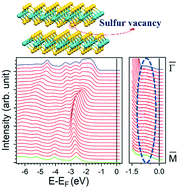Unravelling the effect of sulfur vacancies on the electronic structure of the MoS2 crystal†
Abstract
Molybdenum disulfide (MoS2) is one of the two-dimensional layered semiconductor transition metal dichalcogenides (TMDCs) with great potential in electronics, optoelectronics, and spintronic devices. Sulfur vacancies in MoS2 are the most prevalent defects. However, the effect of sulfur vacancies on the electronic structure of MoS2 is still in dispute. Here we experimentally and theoretically investigated the effect of sulfur vacancies in MoS2. The vacancies were intentionally introduced by thermal annealing of MoS2 crystals in a vacuum environment. Angle-resolved photoemission spectroscopy (ARPES) was used directly to observe the electronic structure of the MoS2 single crystals. The experimental result distinctly revealed the appearance of an occupied defect state just above the valence band maximum (VBM) and an upward shift of the VBM after creating sulfur vacancies. In addition, density functional theory (DFT) calculations also confirmed the existence of the occupied defect state close to the VBM as well as two deep unoccupied states induced by the sulfur vacancies. Our results provide evidence to contradict that sulfur vacancies indicate the origin of n-type behaviour in MoS2. This work provides a rational strategy for tuning the electronic structures of MoS2.



 Please wait while we load your content...
Please wait while we load your content...